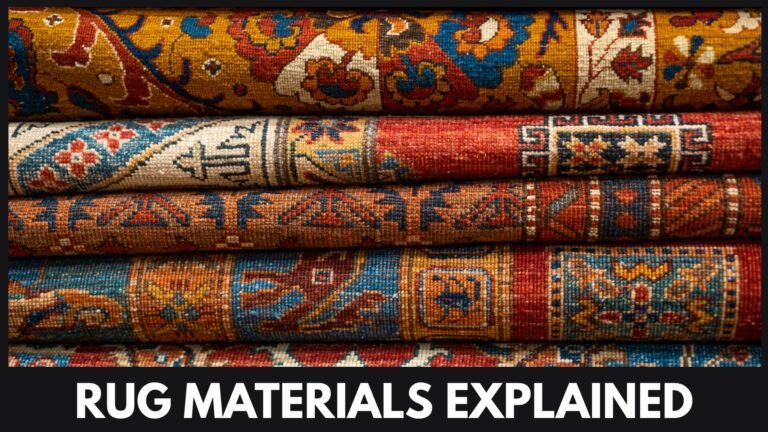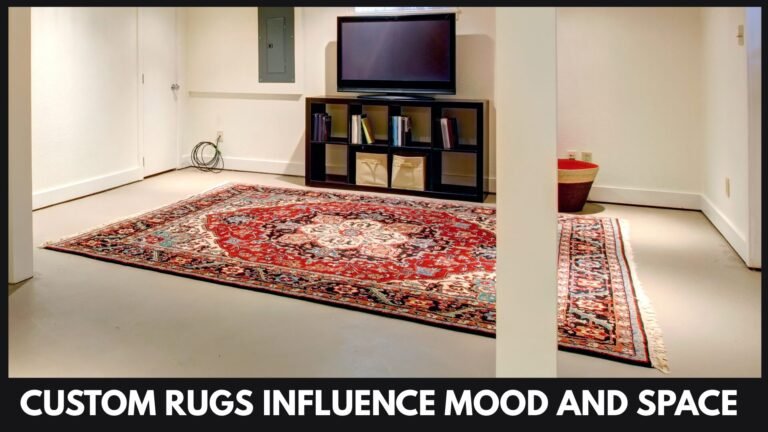
Custom Designed Indian (Mughal-Inspired) Rugs
Indian carpets have a rich legacy that stretches back centuries. Among them, rugs influenced by the Mughal era hold a special place. These rugs combine local weaving traditions with design inspirations that flourished under Mughal patronage. Commonly featuring floral motifs, symmetrical patterns, and intricate borders, they bring warmth and style into both traditional and contemporary homes.
Mughal-inspired rugs, often crafted with fine-quality wool or silk, highlight the craft skills that passed through generations of Indian artisans. Even in modern settings, these rugs can remind us of historical palaces, gardens, and artistic achievements from a remarkable period. At the same time, they adapt well to everyday life in India, balancing aesthetic charm and practical function.
Table of Contents
1. Historical Roots of Mughal-Inspired Rugs
The Mughal Empire, spanning roughly from 1526 to 1857, played a major role in shaping art, architecture, and cultural practices in the Indian subcontinent. During this era, the royal court fostered weaving workshops where expert craftspeople fashioned carpets for royal palaces, mosques, and upscale residences. These carpets became famous for their complex designs, vivid color palettes, and fine weaving.
Many early patterns exhibited noticeable Persian elements, mirroring the connections between the Mughal rulers and Persian culture. Over time, these external ideas merged with local artistry, leading to a signature Mughal style featuring floral designs, fine lines, and reflective symmetry. This style can be seen in garden layouts like those at the Shalimar Bagh in Kashmir and other classic Mughal landmarks.
As weaving traditions evolved, these once-exclusive carpets found their way into the residences of nobles and affluent families. They also gained popularity with traders and collectors, both within India and internationally. Current rug-makers continue to adopt classic weaving techniques, ensuring that present-day Mughal-inspired carpets retain their historical essence.
2. Key Features of Mughal-Inspired Rugs
Although each rug has its own unique characteristics, several elements usually define a Mughal-inspired piece:
- Floral and Botanical Patterns: You will often spot detailed flowers, vines, and leaves reminiscent of the lush Mughal gardens.
- Central Medallions: A standout medallion in the rug’s center, sometimes accompanied by smaller corner motifs, brings a balanced focus to the design.
- Symmetry and Repetition: Many patterns are arranged in mirrored layouts, a nod to the Mughal fondness for balanced and systematic artwork.
- Vibrant Yet Harmonious Colors: Whether the rug uses bold reds and golds or calmer blues and greens, the palette typically feels coordinated, allowing the design details to shine.
- Intricate Knots: Mughal-inspired rugs often have high knot counts, offering sharp detailing and durability.
These distinguishing qualities ensure that a rug styled in the Mughal tradition stands out and can integrate easily with varied home aesthetics.
3. Why Choose a Custom Mughal-Inspired Rug
Ready-made rugs can work well for some households, but they do not always align with personal tastes or special design conditions. Here is why having a custom-made piece can be a smart decision:
- Exact Sizing: Each home is unique. With customization, you can specify dimensions that perfectly suit your furniture layout or a room’s shape.
- Material Choices: Whether you want high-quality wool for a softer feel, silk for a refined sheen, or a blend for cost efficiency, a custom rug gives you these options.
- Personalized Colors: If your living space features warm shades of terracotta or cool tones of pastel, you can match the rug’s color scheme accordingly.
- Pattern Modifications: You can keep traditional Mughal motifs or adjust them for a simpler look—ideal if you have minimalistic decor and want just a hint of historical flair.
Carpetsandrug specializes in guiding clients through these choices, ensuring that every aspect—from rug layout and color palette to material selection—fits your style. This approach leads to a more coherent look, particularly in rooms with distinct design themes or custom furnishings.
4. Materials and Techniques
Mughal-inspired rugs can be woven using different methods and materials:
- Hand-Knotted Wool: This is a standard method in India. Wool retains heat and feels naturally soft. The knotted structure allows for precise detailing, which helps re-create classic Mughal patterns.
- Silk or Silk-Blend: Rugs made with silk are known for their shine and texture, often showing very fine design details. They work best in places with lighter foot traffic to maintain their delicate threads.
- Wool-Cotton Mixtures: Combining wool for the pile and cotton for the foundation provides resilience while being more wallet-friendly than silk. These rugs can be ideal for high-use areas.
Think about foot traffic, temperature, and how often you plan to use the rug. For family gathering spots, a sturdy wool-based or blended material might be more dependable, while a silk blend could add a more refined feel to a quieter space.
5. Colors for Different Interior Styles
India’s wide mix of decor preferences opens up many color choices for Mughal-inspired rugs. Some popular approaches include:
- Deep Reds and Oranges: Evoke the grandeur of Mughal fortresses and palaces. These shades align well with wooden furniture or golden accents.
- Gentle Greens and Blues: Subtle hues bring a calming presence, suitable for rooms that serve as peaceful retreats.
- Creams and Beige: Ideal for modern apartments with minimalist themes, offering a balanced background for lively patterns.
- Gold and Maroon: A richly textured approach to color, often associated with more formal or ceremonial spaces.
When planning a custom piece, coordinate the rug’s tones with your drapes, sofa cushions, and wall colors. Because a rug covers a large surface area, it can either blend in harmoniously or act as a statement piece in your space.
6. Placement Tips for Indian Homes
Mughal-inspired rugs can fit into many areas of a house. Below are suggestions for how to place them effectively:
Living Area
- In Front of the Sofa: Center the rug so at least the front legs of the furniture sit on it, tying the layout together.
- Open Spaces: If you have an open-concept living and dining area, use a large rug in the living zone to create a sense of separation without putting up physical dividers.
Bedroom
- Under the Bed: Place the rug under the bottom two-thirds of the bed so that your feet land on a soft surface when you get up in the morning.
- At the Foot of the Bed: A smaller rug near the footboard can add warmth and style without covering the entire floor.
Dining Room
- Sized for Chairs: Pick a rug that extends at least two feet beyond the edges of the dining table, keeping chairs on the rug even when they are pulled out.
- Pattern Scaling: If your table or chairs feature strong designs, opt for a simpler rug pattern. If the furniture is plain, a more intricate rug can act as the centerpiece.
Hallways and Entries
- Runner Rugs: Custom runners in Mughal patterns can make a corridor feel more inviting.
- Foyer Highlights: A small round or rectangular rug in the entry area can offer an immediate sense of hospitality.
Workspaces
- Under a Desk: In a home office, a medium-sized Mughal-inspired rug can define your workspace. Choose lighter colors if the room lacks natural light.
7. Care and Maintenance
A well-crafted rug can last for years with basic upkeep:
- Vacuum Regularly: Set your vacuum on a gentle mode, especially if the rug has fringe. This reduces dirt accumulation.
- Clean Spills Promptly: If something spills, blot (not rub) with an absorbent cloth. For tougher stains, consult a rug-cleaning specialist.
- Rotate Periodically: Turn your rug every few months to avoid uneven fading or wear from foot traffic.
- Professional Washing: Over time, debris can settle deep in the pile. Consider a professional wash every 12 to 24 months for heavily used rugs.
- Use a Rug Pad: A pad helps reduce friction between the rug and the floor, minimizing damage to the fibers and preventing slippage.
Following these suggestions can preserve the color intensity and weave quality of a Mughal-inspired rug for the long term.
8. Pricing Considerations
Several factors influence the cost of a custom Mughal-inspired rug:
- Size: Larger rugs use more material and need longer weaving hours.
- Materials: Silk or high-quality wool may cost more, while blends can be easier on the budget.
- Knot Density: Highly detailed or dense designs will raise the price because they take longer to craft.
- Brand Reputation: An established brand often charges more but typically guarantees a better level of material quality and artistry.
Before beginning the design process, estimate how much you want to spend. Carpetsandrug can work within different budgets, balancing aesthetics with durability.
9. Working with Carpetsandrug
Carpetsandrug focuses on delivering rugs that reflect both timeless design and modern convenience. Their services include:
- Extensive Design Options: You can choose from a wide range of motifs, borders, and colors.
- Customizable Sizes and Materials: Whether you prefer plush wool or a silk blend, they guide you in making informed choices.
- Expert Support: Their team helps you pick patterns that suit your room’s size and existing decor.
- Quality Assurance: Every stage, from yarn preparation to knotting, is carefully supervised for consistency and lasting quality.
- Hassle-Free Delivery: Clear communication and timely updates mean you stay informed throughout the process.
With a dependable provider at your side, bringing a Mughal-inspired rug into your home is straightforward. The end result is a piece that represents both cultural heritage and modern design flexibility.
Conclusion
Mughal-inspired rugs showcase the long and rich artistic tradition of the Indian subcontinent. They draw from motifs of lush gardens, symmetrical layouts, and vibrant shades that bring energy to any room. Whether you want a grand showpiece for your living room or a small accent for a bedroom corner, these rugs blend decorative flair with usability.
Opting for a custom version offers control over size, color palette, and pattern complexity, making it simpler to match the rug with your home’s character. Carpetsandrug can transform your ideas into reality by guiding you through design choices, material options, and finishing methods. This way, you end up with a piece that not only looks beautiful but also endures everyday living conditions.
By focusing on maintenance, like consistent vacuuming and periodic rotations, you can preserve the rug’s appeal for many years. Moreover, your decision to get a handcrafted piece supports Indian artisans, maintaining a cultural legacy that has stood the test of time.
Frequently Asked Questions
- Is it possible to customize only the size while keeping a classic Mughal pattern?
Yes, dimensions can be altered as needed without changing the original motif. This ensures the rug covers your floor space correctly but retains the design’s character. - How do I pick between a thick wool rug and a wool-cotton blend for the living room?
It depends on foot traffic and your budget. A thick wool rug offers extra warmth and comfort, while a blend provides durability at a more moderate price. - Can I request colors not usually seen in traditional Mughal carpets, such as modern pastel shades?
Absolutely, the colors can be adapted to complement your personal decor theme. This is one of the main benefits of a custom order. - Are custom Mughal-inspired rugs more expensive than standard handmade rugs?
Prices vary based on size, materials, and design detail. Custom rugs may cost more due to specialized weaving or rare dyes, but they provide a unique fit that off-the-shelf items cannot match. - How long does a custom Mughal-inspired rug order typically take from start to finish with Carpetsandrug?
Timeframes differ by project. Simpler designs or smaller pieces might be ready within a few weeks, while intricate or larger rugs could take several months. The team will give you an estimate based on your specific requirements.



